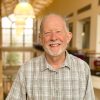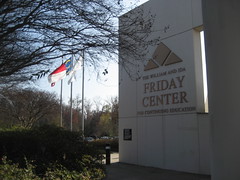This article is more than 5 years old.
On Thursday, November 20, the North Carolina Preservation Consortium held it’s annual conference at the Friday Center in Chapel Hill, NC. The topic this year was “Cultural Respect in Preservation and Conservation”. There were four speakers at the conference, all from a variety of backgrounds and disciplines.
The first speaker was Michele Cloonan, Dean of the Library School at Simmons College in Boston. Cloonan has written extensively on preservation topics, and began the Preservation Program at Brown University. Her topic, “Preserving Collections with a “Respect More Tender, More Holy, and More Profound” focused broadly on respect for cultural property and especially library collections. She discussed the ideas of ethics and moral philosophy and how these affect our decision-making and the prioritization of our materials. She discussed the idea of a book: a book is an object, but it is also a living, breathing thing in the sense it is the embodiment of ideas-and ideas are alive. Cloonan believes preservation should extend broadly to both the book as object and to the ideas contained within it. Michele kept comparing the idea of preservation and cultural respect to the layers on an onion. She stated that preservation has power in it-like an onion has the power to bring tears- she mentioned the bombing of the Buddha in Afghanistan which brought a strong reaction, and some tears as well.
The following speaker was Marian Kamintz, Head of Conservation at the National Museum of the American Indian in Washington, DC. Kamintz spoke on the topic of “Conservation in Collaboration with Native American Communities”. Her main emphasis was on how the museum used collaboration to understand and interpret cultural layers of meaning. Often, Native American communities have individuals who possess traditional skills or knowledge. The museum meets with these individuals to understand materials in their collection, how and why these items were made, how to interpret them and sometimes, how to conserve or restore them. By using different ways of asking questions of 
 native peoples in their consultations, the museum is able to understand their collection more fully-and as a result interpret these for the public. Kamintz focused on three major consultations over objects which garnered the museum much needed information: Siltez Dance regalia (Oregon), Passamaquoddy birch bark canoe (Maine) and a Hamsaml raven mask (Canada). In the case of the Siletz dance regalia, the museum was able to loan this item to the tribe for the first use of this item in an actual dance since it was outlawed in the 19th century.
native peoples in their consultations, the museum is able to understand their collection more fully-and as a result interpret these for the public. Kamintz focused on three major consultations over objects which garnered the museum much needed information: Siltez Dance regalia (Oregon), Passamaquoddy birch bark canoe (Maine) and a Hamsaml raven mask (Canada). In the case of the Siletz dance regalia, the museum was able to loan this item to the tribe for the first use of this item in an actual dance since it was outlawed in the 19th century.
After lunch, Karen Jefferson, Head of Archives and Special Collections at the Atlanta University Center spoke. Karen previously worked at the John Hope Franklin Research Center at Duke, the National Endowment for the Humanities and Howard University. Her talk was entitled: “Serving Many Masters: Legacy Collections in Archives. She spoke of the many entanglements which often arise as individuals or their families give materials to archives. Her library represents 5 universities in the Atlanta area, including Moorhouse College, which recently received the papers of Dr. Martin Luther King Jr. The King papers are considered not only to be research materials, but ritual objects of veneration. Jefferson made the point that African-American women are often neglected by history while men are not. This is an issue Jefferson is not happy about. She said one of the intrinsic problems in collecting from African-American individuals is that often they don;t have “papers”. Civil Rights activists often don’t have a retirement-so their stuff IS their legacy and their only asset. This is difficult to sort out for archivists. For instance, for the MLK papers: the family holds the copyright, Moorhouse College owns the collection and Jefferson’s library is custodian of the collection.
Corine Megener, US Committee for the Blue Shield
The final speaker, and the most compelling, was Corine Wegener, President of the US Committee for the Blue Shield. This group is like the Red Cross for cultural property. Wegener spoke on “The Looting of the Iraq Museum and Cultural Respect during Armed Conflict.” Wegener is a retired Major from the US Army and served 13 years as a Civil Affairs Officer, tasked with protecting cultural property in Bosnia, Africa and Iraq. She described getting permission to go to Iraq in 2003 to help protect materials from the Iraq National Museum which had been damaged in the looting. Since Iraq is the “cradle of civilization”, the items in the museum were historically unique and internationally important. The damage to the museum affected the building and contents, the collections and all the computers. Since all the museums computers were taken, there was no inventory to refer to. This made identifying lost objects difficult. Many objects, such as was cylinder seals, were small, not catalogs, and easy to remove in quantity. fortunately, much of the collection was hidden by curators before the looting began. Many of the items in the collection, however, are still missing-and some have been seized as far away as New York City. This presentation was fascinating. Wegener discussed going to a bombed Iraqui Secret Police building. The basement was flooded because the water pipes were destroyed in the bombing-and many Jewish books, apparently being held secretly in this basement, were submerged or floating. They immediately froze the books on a semi trailer from Jordan, and shipped them to the National Archives. Wegener stated the dilemma: you are not supposed to remove cultural property from it’s home country! The problem is there are no Jews left in Baghdad-the few remaining were removed during the 2003 invasion. So what do we do with this stuff that isn’t ours and has no home to return it to?
An amazing day of information and networking with peers across North Carolina. I was especially gratified to acknowledge 4 scholarship recipients to our conference. this gets our name in front of new professionals and lets them experience a preservation conference and meet leaders from across our state.
Craig Fansler



1 Comment on ‘North Carolina Preservation Consortium Annual Conference’
Great conference and great report, Craig!